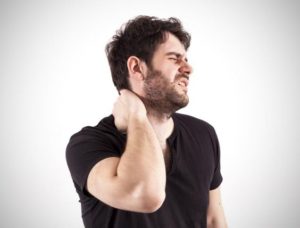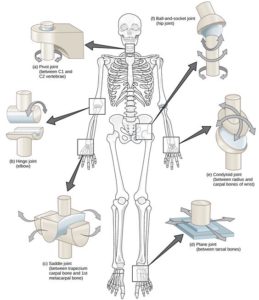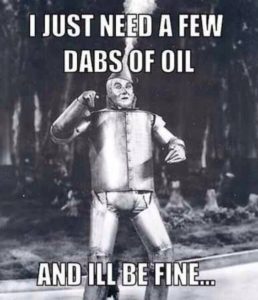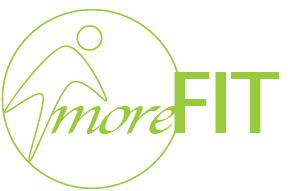Past the Joint of No Return
Does is seems like your joints ache more as you age and when you exercise? The truth is that as we get older, the  more common it is to experience mild soreness or aching when you stand, climb stairs, or exercise. The body does not recover as quickly as it did in younger years.
more common it is to experience mild soreness or aching when you stand, climb stairs, or exercise. The body does not recover as quickly as it did in younger years.
Another cause for the soreness could be because cartilage naturally deteriorates. Cartilage is the smooth tissue that cushions joints and helps them move more easily. As we age, the body’s natural “shock absorbers” wear out, which means we begin feeling more of the physical toll that our bodies are experiencing. In addition, we lose muscle tone and bone strength, which can make physically demanding tasks more difficult and taxing on the body.
*Joints can be classified structurally based upon what kind of material is present in the joint.
– Fibrous joints are made of tough collagen fibers and include the sutures of the skull and the syndesmosis joint that holds the ulna and radius of the forearm together.
– Cartilaginous joints are made of a band of cartilage that binds bones together. Cartilaginous joints include joints between the ribs and costal cartilage and the intervertebral disks of the spine.
– The most common type of joint, the synovial joint, features a fluid-filled space between smooth cartilage pads at the end of articulating bones. Surrounding the joint is a capsule of tough dense irregular connective tissue lined with synovial membrane. The outer layer of capsule may extend into thick, strong bands called ligaments that reinforce the joint and prevent undesired movements and dislocations. Synovial membrane lining the capsule produces the oily synovial fluid that lubricates the joint and reduces friction and wear.
 There are many different classes of synovial joints in the body, including gliding, hinge, saddle, and ball and socket joints.
There are many different classes of synovial joints in the body, including gliding, hinge, saddle, and ball and socket joints.
– Gliding joints, such as the ones between the carpals of the wrist, are found where bones meet as flat surfaces and allow for the bones to glide past one another in any direction.
– Hinge joints, such as the elbow and knee, limit movement in only one direction so that the angle between bones can increase or decrease at the joint. The limited motion at hinge joints provides for more strength and reinforcement from the bones, muscles, and ligaments that make up the joint.
– Saddle joints, such as the one between the first metacarpal and trapezium bone, permit 360 degree motion by allowing the bones to pivot along two axes.
– The shoulder and hip joints form the only ball and socket joints in the body. These joints have the freest range of motion of any joint in the body and are the only joints that can move in a full circle and rotate around their axis. However, its free range of motion makes it more susceptible to dislocation than less mobile joints.
*(Reference: http://www.innerbody.com)
Synovial joints offer the widest range of motion for your body, making them an essential part of exercise. These joints provide lubrication and cushioning to bones and tissues as you exercise. In return, exercising has the potential to maintain synovial joint health. Synovial membrane cells secrete substances called hyaluronan and lubricin into the synovial fluid to increase hyalin cartilage density and elasticity. Synovial fluid also helps protect your body from infection and inflammation.
Common forms of exercise like walking, running, biking and swimming use a variety of synovial joints. Exercising regularly can increase the protective power of synovial fluid, and may potentially help manage arthritis and osteoarthritis. These diseases are characterized by a breakdown of joint cartilage as well as decreases in synovial fluid and increases in inflammatory substances. *Osteoarthritis (OA) is the most common form of arthritis and is also known as degenerative joint disease. According to the Centers for  Disease Control and Prevention (CDC) about 27 million American adults over the age of 25 have osteoarthritis, making OA one of the leading causes of disability in adult Americans. An article in ‘Arthritis Research Therapy’ in July 2010 examined the effects of exercise on women with osteoarthritis of the knee. The study found that women who exercised experienced increases in anti-inflammatory substances in their synovial fluid. In comparison, the non-exercising group did not experience these effects. If you have arthritis or osteoarthritis, talk to your doctor before beginning an exercise program.
Disease Control and Prevention (CDC) about 27 million American adults over the age of 25 have osteoarthritis, making OA one of the leading causes of disability in adult Americans. An article in ‘Arthritis Research Therapy’ in July 2010 examined the effects of exercise on women with osteoarthritis of the knee. The study found that women who exercised experienced increases in anti-inflammatory substances in their synovial fluid. In comparison, the non-exercising group did not experience these effects. If you have arthritis or osteoarthritis, talk to your doctor before beginning an exercise program.
*(Reference: http://www.livestrong.com)
*Most people with osteoarthritis are over the age of 55, but other factors can increase a person’s chances for developing the disease. These biggest contributing factors include:
Excess weight. Being obese or overweight puts additional stress on joints, cartilage, and bones, especially those in the knees. It also means you’re less likely to be physically active.
Family history. Genetics may make a person more likely to develop OA. If you have family members with the disease, you may be at an increased risk of developing OA.
Gender. Before age 45, men are more likely to develop osteoarthritis. After 50, women are more likely to develop OA than men. The difference becomes almost even around age 80.
Occupation. Certain occupations, such as those in construction, agriculture, cleaning, and retail, increase a person’s risk for developing OA. Their bodies are used more rigorously as part of their job, which means their joints are worked more and likely age faster than sit-down jobs.
*(Reference: http://www.healthline.com)
Getting started with exercise, especially lifting weights, can be tough if you are coping with arthritis or joint pain in general, and are unsure of which exercises are the best and safest for your joints. You may have questions, such as:
– How long and how often?
– How much weight?
– How many reps and sets?
– What kind of exercises?
– How do I perform the activity?
Come into moreFIT and talk with our personal trainers about any pain or dis-ease that you may have, especially in your joints. We will take the time to answer your questions and assist you with a personal training program that works for you.
